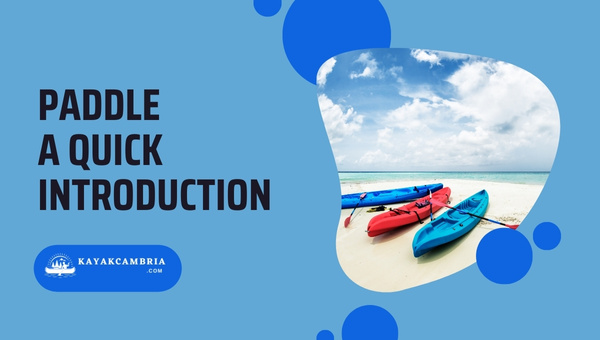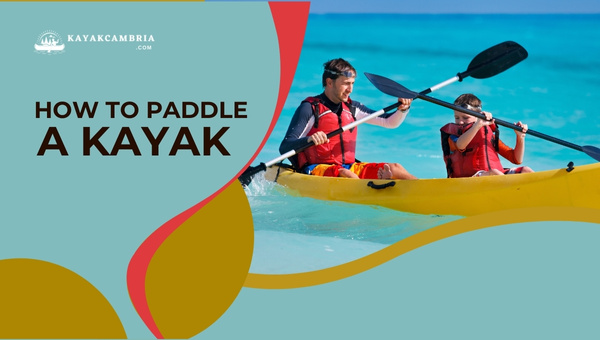Kayak paddling is an enjoyable activity that you can do on still or slow-moving water. It’s a great way to experience nature and give yourself some exercise at the same time. When it comes to kayak paddling, there are a few things that you need to know before getting started. In our blog post, we will provide a comprehensive guide on how to paddle a kayak.
Knowing how to properly paddle a kayak is an essential skill to master before you hit the water. Whenever you paddle, it is important to use the correct techniques and form. This not only makes kayaking more enjoyable but also reduces the risk of injury. So, let’s get started with our guide on how to paddle a kayak.
Contents
Contents
Kayak Paddle – A Quick Introduction
A kayak paddle is composed of two main parts, the shaft, and the blade. The shaft is usually made of aluminum or carbon fiber and can come in different lengths depending on your paddling style and preference. The blade is usually a curved piece of plastic that helps you propel the kayak through the water.

Tips for choosing a good kayak paddle blade:
- Construction material: The most popular construction materials for kayak paddles include aluminum, fiberglass, and carbon fiber. Carbon fiber is considered the best choice for high-performance paddling because it provides the best power transfer.
- Asymmetrical blades: An asymmetrical blade shape helps improve performance in rough water conditions as well as provide more control over your kayak.
- The angle between the blades: The angle between the blades is an important factor to consider when choosing a kayak paddle. A larger angle will provide more power, while a smaller angle will provide more finesse and control.
Tips for choosing a good kayak paddle shaft:
- Construction material: Most kayak paddle shafts are made of aluminum or carbon fiber. Aluminum is a lightweight and durable material, while carbon fiber provides more power transfer.
- Length: The length of your kayak paddle should be adjusted to fit your height. Generally speaking, the longer the paddle shaft is, the easier it will be to propel the kayak.
- Straight or bent: Bent shafts are designed to minimize the risk of injury, as they reduce strain on your wrists and forearms by creating a more natural paddling motion. It’s important to note that bent shafts can be harder to control and may take some getting used to.
How To Hold A Kayak Paddle (2023)
Before we start paddling, it is important to know how to properly hold the kayak paddle. This will ensure that you have maximum control and power over the kayak. Here are the steps to correctly hold a kayak paddle:

- Place your hands on the paddle shaft, making sure that they are shoulder-width apart.
- Make sure that both your hands are at an equal distance from the blade head and that the blades are properly oriented.
- Adjust your grip so that your elbows make a 90-degree angle, while still maintaining a relaxed grip. This is important as it will allow you to transfer power efficiently and accurately while paddling.
How To Size A Kayak Paddle (2023)
The size of a kayak paddle is responsible for the power and performance of the paddling. Knowing the right size is essential to your paddling efficiency and comfort. Here’s how you can choose the best paddle size for you:

- Under 5’5″: A paddle length of an average of 220 to 240 cm is ideal for paddlers under this height.
- 5’5”-5’11”: For people in this height range, a paddle length of an average of 220 to 250 cm is recommended.
- Over 6 feet: Paddle lengths up to 260 cm are suitable for taller paddlers.
How To Paddle A Kayak (2023)
Now that you know the correct way to hold and size your kayak paddle, let’s move on to learning the main techniques on how to paddle a kayak. In this section, we will learn four main kayak paddling techniques – Forward Stroke, Reverse Stroke, Sweep, and Draw.

The Forward Stroke
The Forward Stroke is the most commonly used technique and involves pushing the paddle blades through the water in a straight line. To perform this stroke, you need to put the paddle blade near your toes in the water and then pull it along the side of your kayak until it reaches your hip. Then repeat the same on the other side with another blade.
In order to increase your speed and efficiency with this technique, you need to practice it regularly. The closer your blades stay to the kayak, the straighter kayak will move in the water.
The Reverse Stroke
The Reverse Stroke is the opposite of the Forward Stroke. This technique can be used as a brake to stop the moving kayak. To do the Reverse Stroke, you need to put the blade in at your hips and push it towards your toes, and then repeat the stroke on the opposite side. The blades of the paddle should be placed parallel to the kayak for maximum efficiency.
This technique can be difficult to master, but with practice you will become more proficient.
The Sweep Stroke
You can paddle a kayak forward and backward easily, but turning can be a bit more tricky. To turn your kayak in either direction, you need to use the Sweep Stroke.
To do this, you need to put the paddle blade in at your toes and then draw a large C in the water until the paddle reaches the back of your kayak. Make sure to keep your arm straight on the stroke side when performing this technique.
The Draw Stroke
We’ve talked about forward, backward, and sweep strokes but when it comes to moving your kayak sideways then you have to use the draw stroke.
In order to do this, rotate the paddle blade horizontally, then turn your body towards the direction in which you want to take your kayak. Drop the blade into the water about two feet away from the kayak and then pull it towards you using your lower hand. Keep pulling until the blade hits the side of the kayak. This is a useful technique to pull close to a dock or another boat.
Frequently Asked Questions
1. What is the correct way to hold a kayak paddle?
You should hold your paddle with your hands slightly wider than shoulder-width apart, elbows bent at 90 degrees, and with a relaxed grip.
2. How do you paddle a basic stroke on a kayak?
You can perform a basic forward stroke by pushing the paddle blades through the water in a straight line, starting near your toes and pulling along the side of your kayak until it reaches your hip. Then repeat this motion on the other side with another blade.
3. What is a Sweep Stroke?
The Sweep Stroke is used to turn your kayak in either direction and involves drawing a large C in the water until the paddle reaches the back of your kayak. Make sure to keep your arm straight on the stroke side when performing this technique.
4. Which technique is used to move the kayak sideways?
The Draw Stroke is used to move a kayak sideways. To do this, rotate the paddle blade horizontally, then turn your body towards the direction in which you want to take your kayak.
5. What are the parts of a paddle?
A paddle typically consists of two parts: the shaft and the blade. The shaft is used to hold the paddle together and the blade is curved at the end in order to create a better grip on the water.
Final Words
Paddling a kayak correctly and efficiently takes plenty of practice. In this article, we have discussed the basics of how to hold a kayak paddle, how to paddle a kayak, the parts of the paddle, and the various techniques you can use to move your kayak.
With proper technique and practice, you will be able to confidently maneuver your kayak in any direction or environment. So spend some time out on the water, get comfortable with each stroke, and soon enough you’ll be a kayaking expert!
Good luck and happy paddling!

